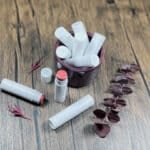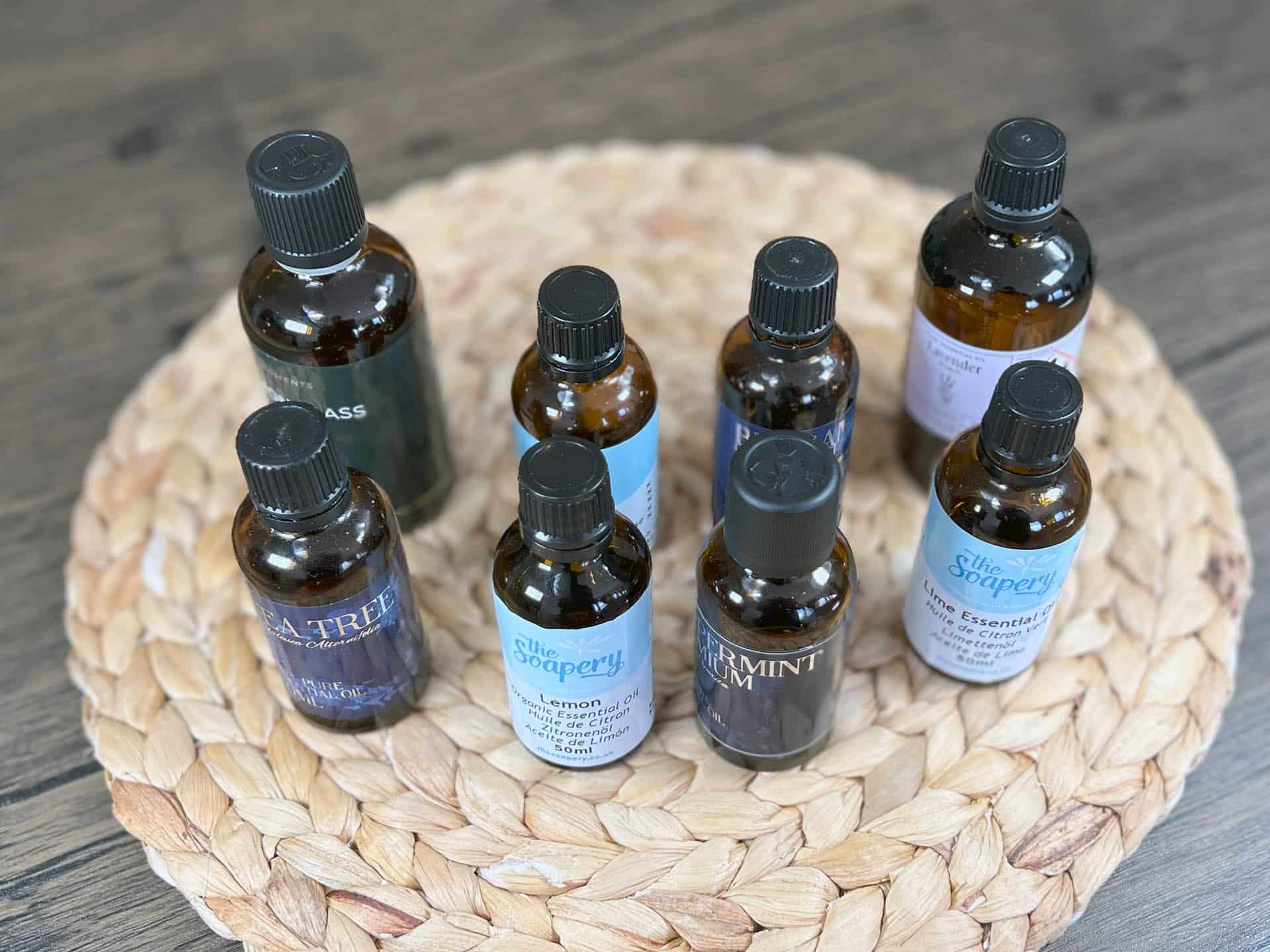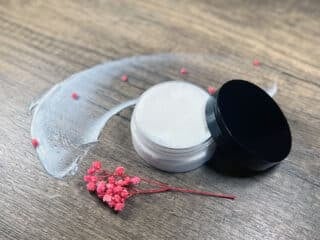My lip balm recipes are designed to do one job – keep your lips soft, smooth and chap free all year round. But what if they were more like a DIY lip gloss? Like a cosmetic that would give your lips a pigment as well as keeping them healthy.
That’s why I’ve formulated a DIY tinted lip balm with fun mica pigments! They’re a lot of fun, and they’re also not quite as pigmented as lipstick – meaning it’s subtle, and you can apply it all day without having to worry about looking like a clown.

Watch How To Make Tinted Lip
Let’s Talk About The Ingredients
This is potentially a great first DIY makeup product for your kids. I’ve made these before with my grandkids and they absolutely love them.
The main problem you have to overcome with a tinted lip balm recipe is to make a formula that glides well on the lips. Otherwise, the product can clump, making your lips look a little weird.
So let’s take a look at how I got this formula to slip and slide on the lips, and look great too!
Cosmetic Waxes
We’re using beeswax here. Beeswax is perhaps the best wax for your balms. It’s great at locking in moisture and protects lips from becoming cracked, chapped, and flaky.
However, it isn’t vegan, so if this is a problem for you, consider taking a look at my vegan lip balm recipe.
Beeswax isn’t the best when we’re talking about skin drag, though. It doesn’t glide very well, so we’ll need to offset that with some other ingredients.

Cosmetic Butters
We’re using two cosmetic butters for this recipe, Cocoa Butter and Mango Butter. We’ve paired mango with shea before, in our Shimmer & Shine Lip Balm.
But it’s a little too soft here because we want to store this product in lip balm tubes. So we’ve swapped the shea butter for cocoa to offset this.
Cocoa butter is an excellent moisturizer, and when combined with mango results in a gorgeous, luxurious balm that doesn’t feel overly greasy.
If you need to substitute anything here, avoid substituting the cocoa butter. A lot of the structure of this product comes from cocoa, because of how seriously hard it is.
But you absolutely can swap the mango butter out for shea butter. But keep in mind that you will need to store them in lip balm pots, as this would make the balm much too soft for a tube.
Carrier Oils
We’ve selected 3 different carrier oils for this formula, chosen for the different benefits that they can bring to our homemade tinted lip balm.
The coconut oil is there to provide excellent slip and glide to this product. This ingredient offsets the tackiness of the beeswax and should allow you to slip and slide it on without any problems. It also provides some good moisturizing benefits and gives us a nice white balm that can be easily pigmented.
We’ve paired this with some castor oil, again for functional benefit. This will help the balm glide on, and synergize with the coconut oil to offset that beeswax. But it also adds a little shine and gloss to the product too.
The last oil we’re using is sweet almond oil. It’s a great all-round carrier oil, but extra good for chapped and cracked lips, because of how excellent it is at moisturizing. It can also help even out lip skin tone too.
Furthermore, research has shown that it could be excellent for mature skin, with some anti-aging benefits. This is potentially an exciting benefit, but more research needs to be done.

Essential Oils
We’ve gotta be a little careful about our essential oils. As EOs are powerful extracts capable of causing skin sensitization, but they can also be extremely toxic if ingested.
There are a small number of lip-safe essential oils that can be used at 0.5%. This adds a very subtle aroma but is more than enough for the amazing therapeutic benefits of these precious oil extracts.
We’ve selected lavender for our lip-safe EO. It’s wonderfully soothing and skin healing, so perfect for anyone with overly dry and cracked lips.
Furthermore, essential oils like lavender can penetrate the very deepest levels of our skin, much deeper than ordinary moisturizing ingredients. They deliver moisture and antioxidants at the core of our skin, where new skin cells are produced.
Lip Safe Essential Oils
There are a handful of essential oils that are lip safe. Take a look at the DIY lip balm basics to learn more about essential oils that are safe to use in your balms, and how to make use of them in a formula.
If you prefer a fun fragrance, you could consider flavoring oils. Not only do these give our balms a nice smell, but they also taste nice too. You will be surprised by the number of varieties on offer. If it tastes nice, they’ll probably make a flavoring oil for it!
If you want to do this, you’ll want to use it at around 2-3%. Try lowering the sweet almond oil by 1.25g and add 1.5g of the flavoring oil instead.
Mica
We’re using mica as our tinting pigment for this balm. They’re great because they’re relatively cheap and come in so many different colors and shades. You’ll be spoiled for choice! Just make sure they’re lip-safe.
We recommend starting with around 2g of mica for a 50g batch. That’s around 4%. But you can increase it up to 10% (5g for a 50g batch) for a deeper, richer color. It really depends on what you’re looking for, as well as your personal preferences.

Tinted Lip Balm Recipe
As an Amazon Associate, I earn from qualifying purchases. If you buy via the links here I may earn a small affiliate commission at no cost to you, please read my affiliate disclosure.
Ingredients
- 16 grams Beeswax
- 13 grams Cocoa Butter
- 4 grams Mango Butter
- 5 grams Coconut Oil (solid)
- 5 grams Castor Oil
- 4 grams Sweet Almond Oil
- 2 grams Mica Powders
- 0.75 grams Vitamin E Oil
- 0.25 grams Lavender Essential Oil
- 5 Lip Balm Tubes (or container)
Video
Instructions
- Weigh the beeswax, cocoa butter, mango butter, coconut oil, and castor oil, into a heatproof container.16 grams Beeswax, 13 grams Cocoa Butter, 4 grams Mango Butter, 5 grams Castor Oil, 5 grams Coconut Oil
- Place the container into a water bath. You can create a water bath by filling a saucepan with a couple of inches of water and bringing it up to a gentle simmer. allowing the waxes and butter to gently melt.
- Once melted remove them from the water bath but keep the water bath close by as you may need it again. Stir in the sweet almond followed by the mica, If it starts to become solid and cloudy you can pop the beaker back into the water to gently re-melt it.4 grams Sweet Almond Oil, 2 grams Mica Powders
- Next we can add the vitamin E followed by the lavender essential oil, stirring after each one.0.75 grams Vitamin E Oil, 0.25 grams Lavender Essential Oil
- Make sure any tubes that you are using are fully twisted down. Pour the oils into lip balm tubes or containers. Lip balm containers can be fully filled, tubes are best with a little space left at the top ready for topping up later. For this, you will need to hang on to a small amount of the balm mix. When filled Leave the lids off, and put them into a cold place to solidify. A fridge is a perfect place for cooling them quickly, they shouldn't take much more than 30 minutes. Once cool, melt the leftover lip balm mix, give it a good stir and top up the tubes.When they are completely solid and cold, you can pop the lids on and leave them to sit for 24 hours before using them. This gives the lip balm time to thicken and bond with the lip balm screw at the bottom of the tube.5 Lip Balm Tubes
Notes
How To Use Tinted Lip Balm
Because we have these in a cute lip balm tube, they’re super easy to use. Simply wind them up and apply directly to the lips. Applying in a circular motion helps to get the product to sink in faster.
Normally I would recommend using this on other parts of your body, but as this is a tinted balm you might not want to. It’ll work for your feet, elbows and knees in a pinch, but you also might look as if you’re bruised in these areas. Consider a different lip balm recipe for your body.
To avoid looking too clown-like, only apply this balm once an hour. Also try not to overapply, as it can look a bit clumpy if you apply too much at once.
How To Store DIY Tinted Lip Balm
Because this balm has cocoa butter in it, it’s stiff enough to use in a lip balm tube. This is a boon, as they make your balms look more professional and make it easier to apply the product.
However, be sure to top up your balms once you’ve done your initial pour. Wax contracts as it hardens, and expands when it’s a liquid. Therefore you will get large sinkholes and some dipping on top of the balm as they cool in the tubes. Topping up can solve this issue.
Providing you’ve used a good quality antioxidant like vitamin e, your tinted balms should last between 6-12 months.
Final Thoughts
This product is most definitely a cross between lip balm and lipstick. Of course, it’s nowhere near as good at transferring a pigment to your lips as actual lipstick. But it can be a fun little treat for when your lips are chapping and you still want color on your lips.
However, its function as a balm is still absolutely excellent. I would use this any day of the week, and will likely use it more and more now it’s getting cold outside.
Let me know how you find this tinted lip balm recipe. Any problems let me know below, and we’ll try and troubleshoot them together. I hope you enjoy this product as much as we did!














Hi, I just found this tutorial and it really interests me! I love the color of your tinted lip balm in the tubes used in your photo. It reminds me of my favorite BB color, Zinnia, which I can no longer find. Do you happen to know the mica powder color you used?
Can you use liquid pigment instead of mica?
Providing the pigment is oil soluble, you could give it a try. However, in my experience, liquid pigments are generally water soluble and would not be suitable here.
Hi! What can be a substitute for coconut oil? Thanks!
Hi Camille,
I would try Babassu oil. It shares many of the characteristics of coconut oil but is derived from a completely different source.